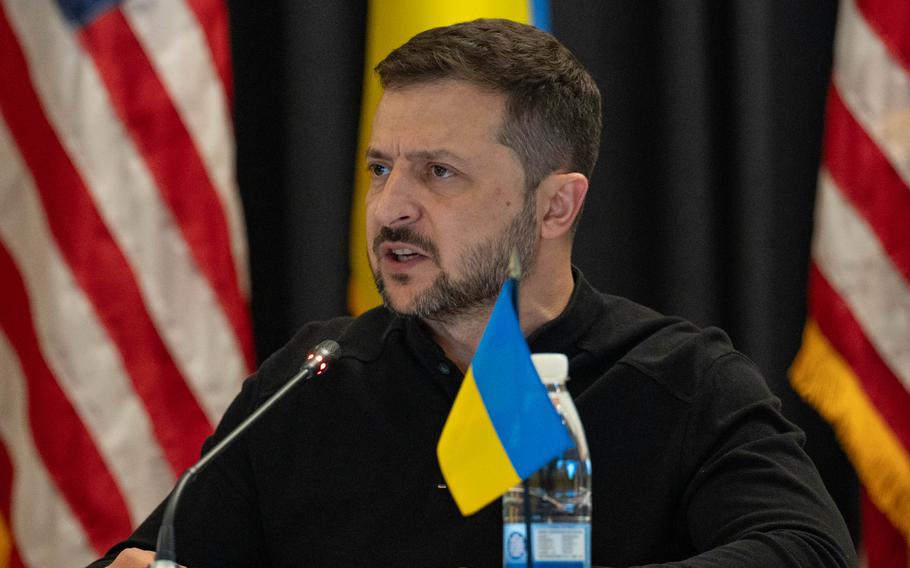
Ukrainian President Volodymyr Zelenskyy speaks during a meeting at Ramstein Air Base, Germany, on Sept 6, 2024. (Eve Daugherty/U.S. Air Force)
The war in Ukraine is going badly for the good guys. Ukraine is slowly losing on the eastern front. Its forces are plagued by a dearth of manpower and ammunition. A summer incursion into Russia made headlines but didn’t change the overall trajectory of the fighting. A deep-strike missile campaign into Russia is potentially promising but has been constrained by Western ambivalence.
Ukraine’s much-touted “Victory Plan” — which includes a push for NATO membership — hasn’t gotten much U.S. support.
As the outlook in Ukraine darkens, there is growing pressure in Washington for a negotiated settlement. The challenge is that no one has figured out how to turn a deteriorating battlefield situation into a decent peace.
Former President Donald Trump’s plan is the simplest: Get Russian leader Vladimir Putin and Ukrainian President Volodymyr Zelenskyy together as soon as possible and threaten them both with dire consequences if the war doesn’t end. Trump could tell Zelenskyy that he risks losing U.S. aid if he doesn’t cut a deal; he might tell Putin that the U.S. will increase that aid, or hit Moscow with harsher sanctions, if Russia resists.
The strategy suits Trump’s tough-guy image. A cutoff of U.S. assistance would quickly bring Ukraine to its knees. Unfortunately, it’s less clear why the threat of more U.S. aid to Ukraine would frighten Putin, given that Trump has spent years complaining about how much the existing aid costs.
One suspects Trump’s plan isn’t about securing a favorable peace, but about securing peace at any cost. Trump seems to envision Ukraine signing away its occupied territories (perhaps swapping its foothold inside Russia at Kursk for minor concessions), and probably agreeing to limits on its relations with the West, in exchange for a cease-fire that won’t last a minute longer than Putin wants it to.
A second approach, with support in Democratic national-security circles, is more realistic in recognizing that Ukraine needs a better hand to play. The U.S. would continue helping the Ukrainians defend their territory, in hopes of eventually making the price of Russian offensives prohibitive. Washington might moderately tighten sanctions, going after some Chinese banks that are facilitating strategic trade with Russia. And if Vice President Kamala Harris wins the election, she might seek another aid package for Ukraine, meant to show Putin he can’t outlast the West and to help Kyiv rebuild for at least the threat of another offensive.
Then, maybe, Ukraine and the West could conduct diplomacy from a position of unity and strength.
Yet this approach, too, has an obvious weakness. If the support the U.S. has provided so far hasn’t made Putin give up, why would a strategy featuring — essentially — more of the same now do the trick? True, Putin is paying an appalling cost per kilometer; he can’t sustain heavy losses in manpower and equipment forever. But given that Russia has nearly four times Ukraine’s population, Zelenskyy’s army may bleed to death before Putin’s does.
The issue here is the same contradiction that has plagued U.S. policy since February 2022. Washington wants Ukraine to win. But for obvious and understandable reasons — the pull of competing priorities in the Pacific, the fear of escalation with Russia — it also wants to limit U.S. involvement.
Alas, we can’t always have everything we want. Today, many believe a peace deal would reduce the costs and risks America bears in supporting Ukraine. But simply getting a deal that isn’t tantamount to surrender may require incurring greater costs and risks than the U.S. has accepted so far.
Putin knows this. Talk of compromise, from the country that has insisted he must be defeated and even overthrown, surely makes him confident that things are going his way. Putin could respond to a peace initiative by holding out for maximalist objectives — annexation of several provinces, sharp curbs on Ukraine’s sovereignty, maybe the overthrow of its government — while his forces continue to bombard and bludgeon.
Or, counterintuitively, he could play along, if he thinks de-escalation now could set him up for victory later. Offering a cease-fire along the current front line would put the burden of continuing the war on Ukraine. It would divide NATO, pitting countries that quietly favor an ugly deal against those who worry it would embolden Moscow further. A cease-fire could lead to sanctions relief, or at least sanctions slippage. And, if Trump wins and the America First ethos prevails in Washington, the West might lose interest in Ukraine once the shooting stops.
Indeed, a peace deal — be it good or bad for Ukraine — won’t bring a lasting resolution to this saga. Putin hasn’t given up on making Ukraine a Russian satrapy. A devastated, rump Ukraine won’t be able to defend itself by itself. So no settlement will last unless the West gives Ukraine the long-term security guarantees, and the military and financial assistance necessary to convince Putin that resuming the conflict is a bad idea.
If the U.S., under Trump or Harris, doesn’t confront that problem squarely, the end of this Russia-Ukraine war could simply start the countdown to the next one.
Hal Brands is a Bloomberg Opinion columnist and the Henry Kissinger Distinguished Professor at Johns Hopkins University’s School of Advanced International Studies. This column does not necessarily reflect the opinion of the editorial board or Bloomberg LP and its owners.